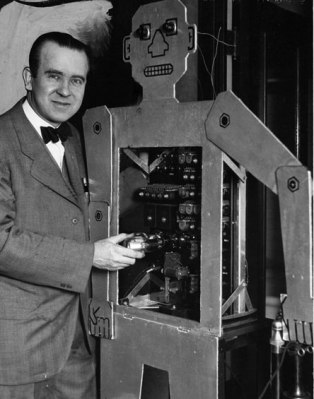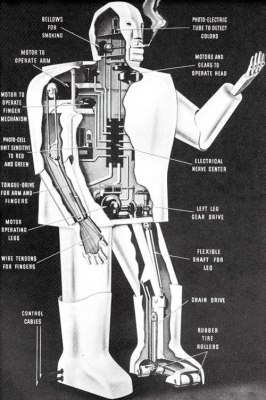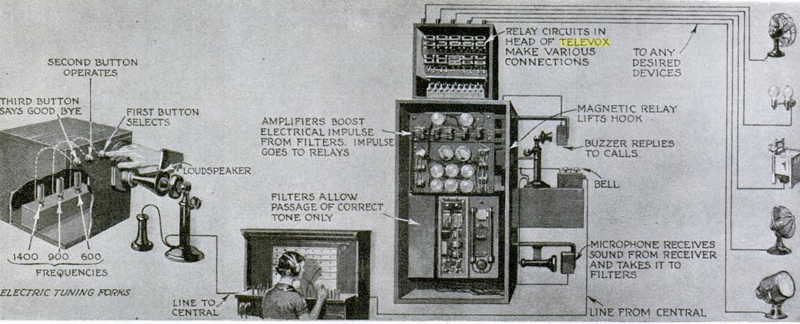When I read old books, I like to look for predictions of the future. Since we are living in that future, it is fun to see how they did. Case in point: I have a copy of “The New Wonder Book of Knowledge”, an anthology from 1941. This was the kind of book you wanted before there was a Wikipedia to read in your spare time. There are articles about how coal is mined, how phonographs work, and the inner workings of a beehive. Not the kind of book you’d grab to look up something specific, but a great book to read if you just want to learn something interesting. In it there are a few articles about technology that seemed ready to take us to the future. One of those is the Televox — a robot from Westinghouse poised to usher in an age of home and industrial mechanical servants. Robots in 1941? Actually, Televox came into being in 1927.
If you were writing about the future in 2001, you might have pictured city sidewalks congested with commuters riding Segways. After all, in 2001, we were told that something was about to hit the market that would “change everything.” It had a known inventor, Dean Kamen, and a significant venture capitalist behind it. While it has found a few niche markets, it isn’t the billion dollar personal transportation juggernaut that was predicted.
But technology is like that. Sometimes things seem poised for greatness and disappear — bubble memory comes to mind. Sometimes things have a few years of success and get replaced by something better. Fax machines or floppy drives, for example. The Televox was a glimpse of what was to come, but not in any way that people imagined in 1941.
What’s in a Name (or a Picture)?
 Demonstrations of Televox included a flat cartoonish-looking robot body. However, when traveling they sometimes wouldn’t ship the body and just cut a new one out of cardboard when they arrived. The photos of Televox looking like a bad Republic serial’s idea of a robot are pretty much press hype.
Demonstrations of Televox included a flat cartoonish-looking robot body. However, when traveling they sometimes wouldn’t ship the body and just cut a new one out of cardboard when they arrived. The photos of Televox looking like a bad Republic serial’s idea of a robot are pretty much press hype.
A more interesting picture forms when you look at the name. The idea was that the “robot” was what we would call an embedded system that you operated via telephone, possibly with your voice. I say possibly because the control was crude. Typically, the input came from vibrating reeds tuned to particular frequencies. The output was also a series of tones you could hear over the phone.
For the purposes of demonstrations, it was possible to find phrases that would vibrate the right reeds so it appeared you were giving voice commands. This reminded me of a kid’s toy 20 years later that accepted voice commands by sensing when you blew air out. The reeds are a bit more sophisticated, but only a little. In practice, you were more likely to blow on a pitch pipe to command Televox than try to do it with speech.
The Real Technology
The real secret behind the Televox wasn’t the cardboard human figure, but a new kind of tube from Westinghouse called a Knowles tube. These were later called grid glow tubes and were similar to thyratrons which would later replace them.
Here’s what the Wonder Book had to say about Knowles tubes:
The Knowles Tube, which is the heart of the televox, is somewhat similar to what the gaseous rectifier uses in radio, except that in addition to the anode and chathode there is a control grid. Alternating current potential is applied across the terminals of the anode and the cathode. The control grid, when free of outside influence, acquires a potential due to the space charge in the tube and blocks the passage of current between the anode and the cathode. However, when the [external] reed vibrates a connection is made to the grid which discharges it and the tube acts as a half-wave rectifier permitting the passage of a pulsating direct current which actuates a relay connected in circuit with the tube.
So in short, the Knowles tube was allowed a ground connection to actuate a relay which could then do any number of things like drive a motor or turn on a light. Some Televox could even talk by way of an endless loop of movie film used only for sound.
Almost a Googlewhack
Have you ever played Googlewhack? That’s the game where you try to find a two word Google query that produces a single result. “Televox Knowles” isn’t quite a Googlewhack — it returns a bunch of results, but only the top two are relevant and they point to the same site: the Cybernetic Zoo.
Despite Westinghouse apparently doing a full press on public relations, there isn’t much information about these on the Internet. However, the cyberzoo site has a lot of magazine article scans and pictures, including an article from Popular Science Monthly from 1928. From that article:
In the ordinary way you telephone your home. When your phone rings, Televox lifts the receiver and utters a combination of buzzes which tell you that you have the right number.
Now you sound a single high note from the first pipe which means “Hello, get set for action.” Televox stops buzzing and responds with a series of clicks, saying “All set; what do you want?”
Next you sound two short notes from the same pipe. These tell Telvox to connect you with the switch on the electric oven.
This is the 1928 version of Amazon Echo or Google Home!
Grid Glow Tube
There is more technical detail about grid glow tubes, though, and it doesn’t always match up exactly with the text in the Wonder book (which, admittedly, isn’t a technical reference). The cathode has a coating to improve emission. Voltage from cathode to anode causes current to flow and the gas within to ionize making a pinkish-green glow. A voltage on the grid can stop the flow of current if the current isn’t already flowing. Once the current flows, however, you have to lower the voltage to reset the tube to the off state.
The grid glow tube didn’t last because the similar thyratron did a better job. It could handle much more current. They also employed filaments for emission so they didn’t start as fast and they consumed power even when switched off.
In Culture
 Televox’s grandson was at the 1939 New York’s World Fair. Elektro, like a lot of Westinghouse robots, was able to smoke cigars or cigarettes and he appeared in a movie, “The Middleton Family at the New York World’s Fair” which you can see below. Elektro was nearly 7 feet tall and weighed 260 pounds. The great quote in that video: “If he wasn’t so big, I’d take him for an engineer.” We will have to ponder exactly what that means. Elektro even had a robot dog, Sparko, that appeared with him in the 1940 fair. Oddly enough, Elektro was in another movie — you can’t make this stuff up — “Sex Kittens Go to College.”
Televox’s grandson was at the 1939 New York’s World Fair. Elektro, like a lot of Westinghouse robots, was able to smoke cigars or cigarettes and he appeared in a movie, “The Middleton Family at the New York World’s Fair” which you can see below. Elektro was nearly 7 feet tall and weighed 260 pounds. The great quote in that video: “If he wasn’t so big, I’d take him for an engineer.” We will have to ponder exactly what that means. Elektro even had a robot dog, Sparko, that appeared with him in the 1940 fair. Oddly enough, Elektro was in another movie — you can’t make this stuff up — “Sex Kittens Go to College.”
Watching the video, it is hard to tell if Elektro picked up specific frequencies or just the number of utterances in a row. In other words, a three-word command must be “Elektro come here” even if it sounded like “Cat food sale.” The effect also includes the operator speaking to Elektro during a conversation without using the microphone. Elektro wasn’t listening, just running through a prerecorded pause.
Elektro replaced his predecessor, Willie Vocalite who worked the 1932 fair. You have to wonder if Westinghouse really thought these were leading to something practical or if it was just more memorable to show a robot over a light bulb?
Where are the Robots?
If you subtract out the anthropomorphism, the Westinghouse prediction wasn’t bad. Most of us do have robots now that answer the phone, vacuum the floors, turn the lights on and off, While our robots typically don’t have legs and a head, they do have ears and respond — often correctly — to a spoken command.
Perhaps Televox wasn’t such a bad prediction after all. The root idea — voice control of automated systems — has become largely practical in the last decade. When we talk about quantum computers, nanotechnology, and DNA manipulation, you have to wonder what will seem outdated in 100 years and what core ideas will continue to survive in some form or another.















“This was the kind of book you wanted before there was a Wikipedia to read in your spare time. There are articles about how coal is mined, how phonographs work, and the inner workings of a beehive. ”
The lost art of informative illustration.
In the 1940’s I had a kids-level encyclopedia called the Book of Knowledge. It had articles much the same as the ones you describe in the New Wonder book. I wonder if the one was a single-volume version of the other.
Check out a “reader” used by American frontier schoolkids in the late 1800’s and early 1900’s. You can sometimes find these in the small mining town museums of fly-over states.
The reader was what the teacher taught from, and had a wealth of information that was just fascinating: stories of war battles, how to use a knife, wilderness survival tips, how to tie knots, famous stories and poems, history, numbers and counting… the whole thing was geared to present useful information in a way that was captivating to the average student.
I mean – all the sections were interesting to read. A motivated kid who learned to read could absorb the entire thing without a schoolmarm assigning homework.
Compare with the textbooks kids have to deal with today: dry and boring, it makes learning so tedious and difficult that most high school graduates can barely read and associate learning with pain.
That’s so true, I’ve been ranting about how boring school material has become. Also note how they release jumbled ‘new editions’ forcing students to buy new instead of used books. Compare quality of explanation to the ‘readers’ you mention, Asimov or any motivated hacker blog and wonder why this is not addressed more often.
My first electronics-specific book was from 1950’s, a translation from Russian. I learned from it all about protons, electrons, vacuum tubes, those new inventions, called semiconductors, and who was Lenin. There were some interesting stories about, for example, how Nazis used directional transmitters to direct their bombers over Great Britain, and how the British retransmitted those signals back to confuse the enemy pilots.
Few years later I’ve got another book from that period, another translation from Russian, but with propaganda turned to the 11. It included, I kid you not, “quotes” (fake ones) from letters written by Marx and Engels. Also aside from few imperialists, like Faraday, Volta, Ampere or Ohm, all science and technology related to electricity and electronics was invented in Soviet Russia. It was much less informative than the first one…
One thing they missed in their predictions is that giving commands, whether by voice or by press of a button, is still work.
Bubble memory had a good run in CNC and robot controls, because it’s nonvolatile but has indefinite write lifespan. (Something still unmatched by most would-be successors. FRAM comes to mind.)
I believe it’s used to store the axis positions, so the machine doesn’t lose position in a power failure. Since some machines, after being built and fixtured, can’t hit their homing switches anymore, this turns out to be very important.
Bubble ram are very closely related to CCD camera sensors, which are still superior to CMOS in most senses except in price. CCD based cameras can be built with an elongated sensor chip which has half the frame physically covered, so you expose one half of the sensor and then strobe the bucket brigade to very rapidly shift the recorded image into the covered half, after which you can strobe it out more slowly to your ADC. This has the effect of reducing the rolling shutter effect prevalent in CMOS sensors which have to be read out pixel by pixel and line by line: you effectively capture one still frame instead of scanning the view. In old style TV cameras, the CCD was simply strobed out line by line in sync with the television scanning beam, producing a direct analog signal.
Also, because of the different style in which a CCD is read out, you have more time to measure the charge stored in each cell and you get greater dynamic range and less noise compared to CMOS sensors.
Unfortunately, due to CMOS winning out in the price competition (due to smaller chip area), you can’t find consumer grade cameras with CCD sensors anymore, and the professional market is mostly CMOS now as well. The result is poor low-light performance and weebly-wobbly video recording.
That’s why old digital cameras from the turn of the century tend to produce better looking images than newer CMOS cameras, despite the much higher resolution of the newer ones. The older cameras often have larger, glass lenses that also help make for better pictures.
And someone’s still using Televox as a system name
The book “Robots of Westinghouse: 1924 – Today” by Scott Schaut goes into great detail about Willie Vocalite, Televox, and Elektro. It seems to be out of print, but you might find it at a library somewhere. To be honest, it’s not all that well written and needed an editor (“sensor” is spelled “censor”, for example), but it’s bursting with more technical details about the Westinghouse robots than any other reference I’ve seen.
Check out the story “A Logic Named Joe” some time. It talks about a thing called a “logic” that was in everyone’s home, and could be used to call up information from anywhere in the world and otherwise do computing tasks for the family. With the exception of the plotline (one of the logica achieves sentience), it’s a remarkable prediction of the internet we have today – in 1946.
WHAT?! I read a logic named joe, and I thought it was more or less contemporary sci-fi. Very impressive.
Not any more… Now googling “Televox Knowles” returns this page. :)
I have a 1905 version of such an all in one. It’s filled with frighteningly stuffy manners and etiquette sections and the latest in flight, science, and industry. It’s on to the Wrights and Alberto Santos Dumont. But the 10 year old copied view of “warfare of the future” is a hoot, with bat-winged infantry flying around a classic star shaped fort defended with cannon and a sky full of balloons.
Bender learned his bad habits from his grandfather.
If you are the type of individual that would rather go to the source and spend hours, days, weeks, months digging through the gems that got us where we are today, then I highly recommend becoming familiar with https://www.americanradiohistory.com/
– very interesting link – thank you!
It’s a good thing Westinghouse didn’t team up with Bell Labs, who demonstrated their Voder at the 1939 fair. Combine those two with a wire recorder and the world may have ‘benefited’ from automated voice mail and literal robo-calls 60~70 years sooner.
Even better when the robo-call is hooked to a speech recognition system. I’m get to practice my Turing testing.. Some of them are pretty good, but they all eventually give themselves away.
Funnily, today, still a lot of Americans will feel or claim they invented all of modern science or technology. It’s so frequent to meet people who think American universities are the only or main ones driving innovation, just because they are good at marketing. (MIT and other “Ivy” league colleges being a prime example.)
Propaganda is still alive, some countries are just more used to it than others, and don’t notice it as much.
Included, in case you are wondering: https://youtu.be/rz9TXhs4Cjk